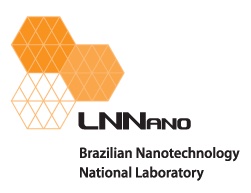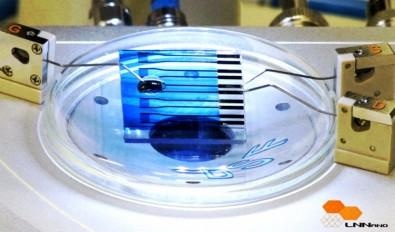Cancer, Alzheimer’s, Parkinson’s Molecules Detected on New Inexpensive Portable Device

 An inexpensive, portable biosensor device developed by researchers at the National Nanotechnology Laboratory (LNNano) in Campinas, São Paulo, Brazil, has proven capable of detecting molecules associated with neurodegenerative diseases such as Alzheimer’s and Parkinson’s diseases, and certain types of cancer.
An inexpensive, portable biosensor device developed by researchers at the National Nanotechnology Laboratory (LNNano) in Campinas, São Paulo, Brazil, has proven capable of detecting molecules associated with neurodegenerative diseases such as Alzheimer’s and Parkinson’s diseases, and certain types of cancer.
Essentially a single-layer organic nanometer-scale transistor on a glass slide, the device’s biosensor contains a reduced form of the peptide glutathione (GSH), a substance that reacts in a specific way in contact with the enzyme glutathione S-transferase (GST), which is linked to Parkinson’s, Alzheimer’s and breast cancer, among other disorders. The glutathione/glutathione S-transferase GSH and GST reaction is detected by the transistor, which has practical potential for diagnostic purposes.
 Portable biosensor has been developed by researchers at Brazil’s National Nanotechnology Laboratory with FAPESP support – Photo Credit: LNNano
Portable biosensor has been developed by researchers at Brazil’s National Nanotechnology Laboratory with FAPESP support – Photo Credit: LNNano
 The biosensor was developed as part of the thematic project “Development of novel strategic materials for integrated analytical devices,“ funded by the São Paulo Research Foundation (FAPESP) – an independent public foundation whose mission is to foster research and the scientific and technological development of the State of São Paulo.
The biosensor was developed as part of the thematic project “Development of novel strategic materials for integrated analytical devices,“ funded by the São Paulo Research Foundation (FAPESP) – an independent public foundation whose mission is to foster research and the scientific and technological development of the State of São Paulo.
Since created in 1962, FAPESP has supported the training of approximately 112,000 scientists from undergraduate to postdoctoral levels; provided financial backing to 96,000 individual and thematic research projects; and funded substantial improvements to the research infrastructure. Half of Brazil’s science output is from São Paulo. According to Science For Brazil, more scientific articles are currently published by researchers from the state of São Paulo alone than from any other country in Latin America. In fact, 1.52% of Brazil’s GDP is being invested in research and development (R&D), a figure surpassing the R&D expenditures of Spain, Italy, Portugal, Mexico, Argentina, and Chile,
The LNNanos project under which the biosensor was developed, is dedicated to creating point-of-care devices using workable materials to produce simple sensors and microfluidic systems, for rapid diagnosis by researchers in many fields.
 “Platforms like this one can be deployed to diagnose complex diseases quickly, safely and relatively cheaply, using nanometer-scale systems to identify molecules of interest in the material analyzed,” said Carlos Cesar Bof Bufon, head of LNNanos Functional Devices & Systems Lab(DSF), in a press release.
“Platforms like this one can be deployed to diagnose complex diseases quickly, safely and relatively cheaply, using nanometer-scale systems to identify molecules of interest in the material analyzed,” said Carlos Cesar Bof Bufon, head of LNNanos Functional Devices & Systems Lab(DSF), in a press release.
Bof Bufon is a member of the project research team. The principal investigator is Dr. Lauro Tatsuo Kubota, coordinator of the Laboratory of Electrochemistry, Electroanalytics and Sensor Development (LEEDS) and current director of the Chemistry Institute (IQ) at the State University of Campinas (UNICAMP).
In addition to portability and low cost, advantages of the LNNanos nanometric biosensor include its sensitivity in detecting molecules, according to Bufon.
“This is the first time organic transistor technology has been used in detecting the pair GSH-GST, which is important in diagnosing degenerative diseases, for example,” said Bufon. “The device can detect such molecules even when they’re present at very low levels in the examined material, thanks to its nanometric sensitivity”.
For perspective: A nanometer (nm) is one billionth of a meter (10-9 meter), or one millionth of a millimeter.
The phthalocyanine-based water-gated transistor biosensor’s system can be adapted for a range of practical applications and to detect other substances, such as molecules linked to various diseases and elements present in contaminated material. Adaptations require replacing the molecules in the sensor with others that react with the chemicals targeted by a particular test. The chemicals to be identified and measured are called analytes.
“LNNanos Functional Devices & Systems division has developed several platforms for chemical, physical and biological sensing in areas of strategic importance both at home and abroad, such as health, environment and energy,” Bufon said. “The goal is to have a series of solutions in the shape of point-of-care devices to respond with agility to a wide array of requirements. These include outbreaks of disease or the need to detect contaminants such as lead and toxins in water samples”.
Research leading development of the biosensor to detect neurodegenerative disease and cancer molecules is reported in the article “Water-Gated Phthalocyanine Transistors: Operation and Transduction of the Peptide-Enzyme Interaction,“ published in the April issue of Organic Electronics. The report is coauthored by Rafael Furlan de Oliveira, Leandro Mercesa, Tatiana Parra Velloa, and Bufon – all four of whom are affiliated with LNNano.
The team is also working on paper-based biosensors to lower the cost of the device even further, improve portability, and facilitate fabrication and easy disposal.
“Paper offers a number of advantages as a platform for analytical devices,” Bufon said. “It’s a natural polymer, widely available everywhere, lightweight, biodegradable, portable, and foldable”.
But paper presents a major challenge because it acts as an insulator in its usual form. For that, Bufon has developed a technique to make paper conductive and capable of transporting sensing data by impregnating cellulose fibers with polymers that have conductive properties.
“The technique is based on in situ synthesis of conductive polymers,” Bufon explained. “For the polymers not to remain trapped on the surface of the paper, they have to be synthesized inside and between the pores of the cellulose fibers. This is done by gas-phase chemical polymerization: a liquid oxidant is infiltrated into the paper, which is then exposed to monomers in the gas phase.”
A monomer is a molecule of low molecular weight capable of reacting with identical or different molecules of low molecular weight to form a polymer.
“The monomers evaporate under the paper and penetrate the pores of the fibers at the submicrometer scale. Inside the pores, they blend with the oxidant and begin the polymerization process right there, impregnating the entire material,” Bufon said. “It’s like filling a room with balloons. If they don’t fit through the door when inflated, the alternative is to inflate them inside the room.”
Simply put, the polymerized paper acquires conductive properties of the polymers which can be adjusted by manipulating the element embedded in the cellulose fibers, depending on the application for which the paper is designed. Consequently, the device can be electrically conductive, allowing current to flow without significant losses, or semiconductive, interaction with specific molecule, thereby functioning as a physical, chemical or electrochemical sensor.
Sources:
São Paulo Research Foundation (FAPESP)
National Nanotechnology Laboratory (LNNano)
State University of Campinas (UNICAMP)
Organic Electronics






